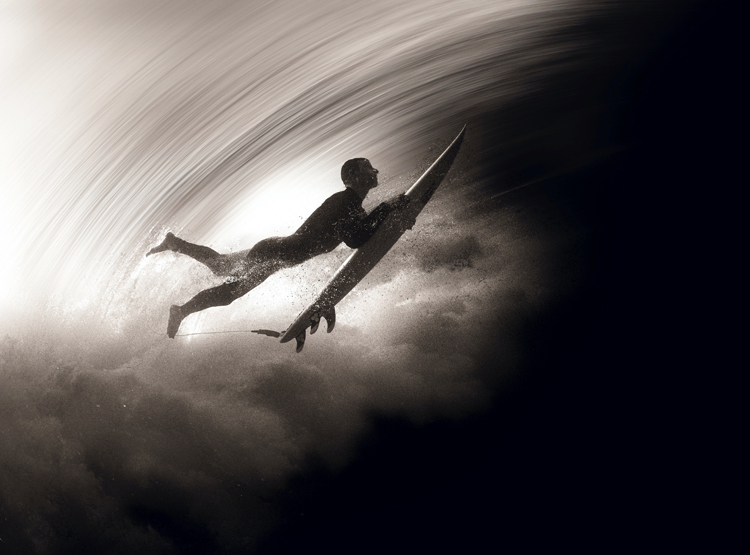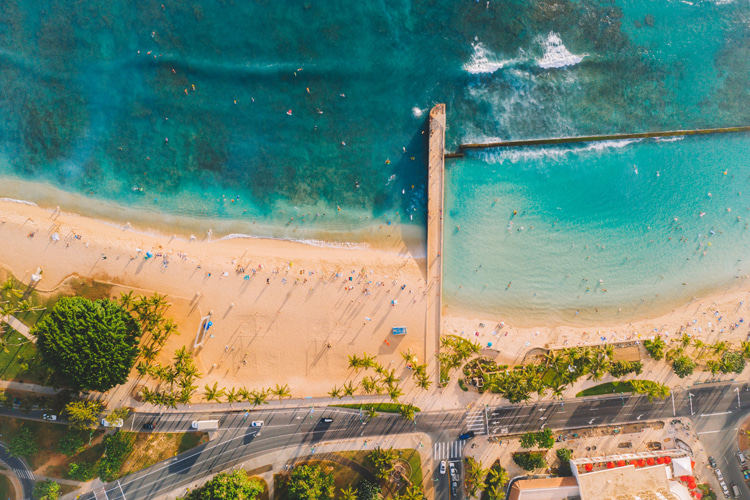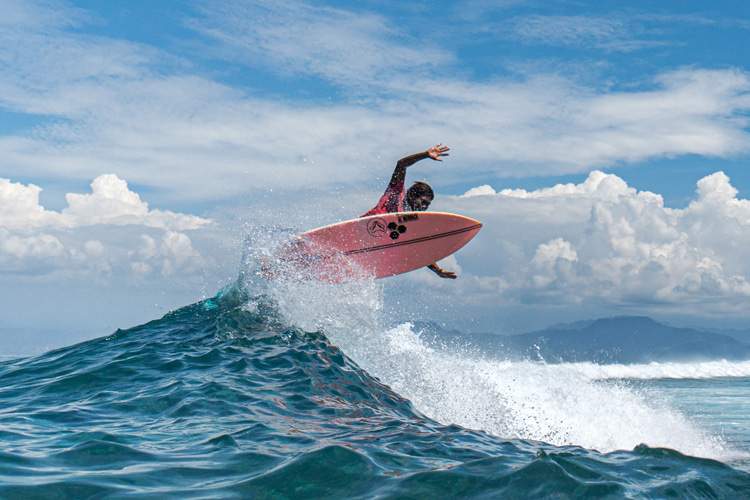One of the best ways of portraying surfing is by showing a color palette with a vast spectrum of hues with subtle variations.
Nothing compares to surfing.
It might sound like one of the multiple clichés poured into words throughout nearly 100 years of surf writing, but it's true.
One of the reasons why the concept of surfing comes with a broad array of imagery has to do with its roots.
No one can precisely trace the exact moment the act of riding the energy of waves became a noble and royal pastime, a way of returning to shore after a fishing session, a semi-religious practice, and then a sport.
The aura of uncertainty and mystery surrounding what we started to call surfing in the 20th century helped build the multidimensional phenomenon we have today.
And today's wave-riding experience is extraordinarily vibrant.
Several books have been written about the social, cultural, economic, and even political implications that surfing had throughout the decades.
They list hundreds of spectacularly real events that shaped the history of societies and surfing, in which the world outside and the sport interact and change themselves forever.
You can always say that, for instance, football (soccer in North America) followed a similar and more intricate path.
It's true.
The history of association football is full of variables of influence and power in global societies since the first goal was scored somewhere in England in the 19th century.
Like surfing, the roots of modern football also have their origins in ancient Greek and Chinese cultures, with several kicking ball game variations.
Modern surfing is a spectacularly rich phenomenon, with endless influential variables "contaminating" mainstream living.
But what multidisciplinary angles make this outdoor activity such a complex reality?

Culture: Lifestyle, Fashion, Habits, and Language
The concept of culture can be vast and nearly endless but generally applies to intellectual human manifestations and behaviors.
The people of surfing are often distinguishable, not only because of their physical characteristics but also their habits.
Surfers have been developing a unique lifestyle, anchored near coastlines, with their relatively laid-back attitude and swell-driven way of living.
Today, though, they're everywhere - living a simple life on a farm or fishing village or managing a multinational company.
Developed in and out of the water, the surfers' lingo evolved and became part of popular culture via Hollywood or mainstream media.
Sooner or later, surfwear became a necessity fueled by a growing background industry eager to fill any commercial space available in the gear and apparel segments.
The organic popularity of surfing did the rest, with millions of "ambassadors" spreading the excitement and the stoke.
And so surf magazines were created, and feelings were translated into words and iconic photographs.
Modern surf culture is now also incorporating various types of entertainment products like video games, comedy, vlogging acts, etc.
Arts: Movies, Painting, Design, Photography, and Music
As soon as the lifestyle was set and consolidated, the bridge between the ballet of the waves and the arts was built.
The period between the post-World War II and the 1960s was particularly enlightening for the establishment of the first surf art experiments.
It's fair to say that surfing is a presence in the so-called seven arts.
The pleasurable experience of navigating the ocean pushed by a wave gave birth to a continuous creative process that touched music, painting, sculpture, performing, literature, film, and even architecture.
Yes, architecture. Take, for instance, the famous and protected Windansea Surf Shack.
Surf movies became a widely respected subgenre within the film industry, with several acclaimed filmmakers, actors, and actresses crossing the mainstream frontier into the water sports experience.
The same occurred in pictures and sounds, with surf photography and surf music becoming established professional entities.
Visual artists like painters and designers also found niche occupations and helped develop a surf-influenced movement.

Travel
Traveling is part of any surfer's DNA.
Searching is inevitable, as perfect waves pop randomly, here and there, depending on the ocean conditions.
The debate on whether surfers are tourists or travelers is useless.
Someone who is searching is always a traveler - an English Egyptologist is an explorer and a hunter. They are looking for something special, something specific.
However, surf tourism is a consequence of surfers being travelers, a business niche equivalent to golf that revolutionized coastal villages and towns worldwide, with Nazaré, in Portugal, as one of the latest huge examples.
But you can now also find surf inland thanks to wave pools or in the center of populated cities, with the Swiss Alps and Munich as paradigmatic cases, respectively.
Science: Oceanography, Meteorology, and Hydrodynamics
The need to know when and where to go in advance is one of surfing's greatest questions.
Therefore, apart from crystal balls and other fortune-telling methods, science is key to predicting how and when the ocean will deliver surfer's raw material.
Surf forecasting also became a subgenre of meteorology and oceanography combined together.
Storms, swells, and winds are important, but geomorphology and bathymetry play a critical role in shaping rideable waves.
Therefore, the science of surf reached such an advanced development stage that it is now a product and service purchased by government services and global corporations.
The accuracy level of these predictions and fine-tuned weather and ocean forecasting models is unprecedented.
Last but not least, it's paramount to refer to the role of hydrodynamics in surfboard shaping.
The modern surfboard (and its fins) is a sensitive sum of plenty of variables designed to adapt to different wave types and users.
The level of detail in surfboard manufacturing is high, making it a field that you can roughly compare to Formula 1 cars' aerodynamic components.

Nature
There are few popular sports, like surfing, that are absolutely dependent on Nature's plans for our planet.
Surfing truly relies on Mother Nature's somehow unpredictable formulas to take place.
Interestingly, the sport's Achilles heel is also its greatest added value.
It's hard to put into words and describe what your body and mind experience when transported over the surface of the water.
It's really the perfect marriage between our human existence and the natural elements. It's like walking on the Moon with only low gravity forces at play.
And then the surroundings.
Water, beaches, headlands, valleys, deserts, dunes, mountains, forests, tropical jungles. And infinite horizons, sunsets, sunrises, fast-moving cloud castles, rain, sun, snow, and offshore winds.
Surfing is a relationship between one and its Creator.
Health: Swimming, Yoga, Pilates, and Nutrition
Surfing invites us to choose what we want our bodies to be when the perfect wave - the wave of our dreams - finally arrives.
And at some point in your life, preferably sooner than later, it poses a few silent questions.
What do I like most? Cigarettes or more time in the water? Fast food or a healthy diet? A stressful or relaxed lifestyle? A lethargic, inactive body or a lean and fit figure?
The adherence to a surfing lifestyle normally comes with various body and mind practices.
Being ready to tackle summer and winter swells consecutively requires a determined mindset and being ready to adopt healthy daily routines.
The more a surfer gets old, the more you see them embracing parallel activities and behaviors like swimming, yoga, Pilates, and balanced food and drink diets.
You don't need to take it to the extreme, but there's certainly a positive linear correlation between both universes.
There is even a growing mental health trend, which sees doctors "prescribing" surfing to their patients.
Environment
Without the ocean, surfers are nothing.
Surfing's intimate marriage with Nature and the environment automatically engages its participants with its protection.
Even though we could make better work, it's undeniable that wave riders are at the forefront of the global ocean protection movements.
Surfrider Foundation is only one of the many non-governmental organizations taking ocean and marine life preservation as a daily occupation, with hundreds of political and legal battles won throughout the decades.
The protection of water resources and the smart management of coastal features go hand in hand with what it means to be a surfer today.
More and more surfers are aware of that and climbing their way into the natural conservation army ranks.
It could start with a simple beach cleanup and end up in a court defending, for instance, public beach access to all.
Spirituality and Religion
In ancient Hawaii, surfing was deeply embedded in religious traditions.
Surfing wasn't just a sport or recreational activity; it was an art that held deep spiritual meaning.
Chiefs, who were figures of authority and reverence, had personal surf chants celebrating their surfing abilities.
The process of making a surfboard in ancient Hawaii was also ritualistic.
Before felling a tree to craft a surfboard, a kahuna (priest) would offer prayers and conduct religious rites.
The ancient Hawaiians believed that the trees used to craft surfboards possessed souls.
Heiaus, the Hawaiian places of worship, encompassed not just constructed temples but also natural features, reiterating the Hawaiian tendency to find spirituality intertwined with Nature.
The fact that an activity like surfing was associated with a dedicated cult or deity highlights its significance.
Today, the spiritual essence of surfing continues, with many surfers intertwining their love for surfing with their own religious or spiritual beliefs.
The existence of church services on beaches followed by surf sessions, like in Huntington Beach, California, exemplifies this blend of faith and love for the ocean.
Surfing isn't just an individual spiritual journey; it's a communal one.
Events like the Eddie Aikau memorial service showcase how the surfing community comes together to remember and honor their own.
The ceremonies are often inclusive, allowing non-surfers to participate and witness, reinforcing the community aspect.
Words by Luís MP | Founder of SurferToday.com
